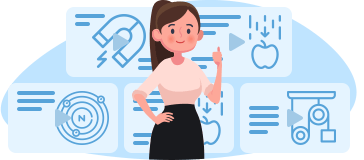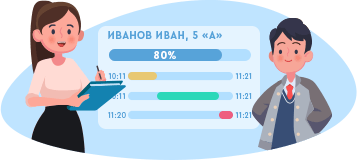I wonder what song she is listening to… I’m dying to know. Well, here she is, and I’m going to eavesdrop on the song.

As I was going over the Cork and Kerry mountains
I saw Captain Farrell and his money he was counting…
Well-well-well… was going and was counting. Something new, don’t you think?
Oh, here she is again…
I was crying when I met you
Now I'm trying to forget you
Your love is sweet misery…
This girl prefers rock, definitely.
So, we’ve got ‘was crying’ and ‘am trying’. Let’s put them all together.
So, ‘was going’, ‘was counting’, ‘was crying’ and ‘am trying’. They are all similar. And the first one we have already known.
Do you remember? This tense is Present Continuous. We use it when we need to describe actions that are happening at the moment, and we put am/is/are and a verb ending with -ing.

But look at the rest. They all have verbs ending with -ing and they all have was. Actually, am/is/are/was/were are just forms of the verb ‘to be’.
If we use ‘am/is/are’ for Present Continuous, then it means that ‘was/were’ refer to Past Continuous Tense.
Am and is were changed to was because some events from the past were described in those songs.
So, we use was after singular objects, or the pronouns such as I/he/she/it and were after plural ones, or the pronouns we/you/they.
Hope, you remember the rule how to add –ing. Just in case somebody forgets it:
|
For many verbs we make the -ing form by simply adding -ing to the end of the verb. |
For the verbs ending in –e or –ue we drop e and only then add -ing. |
But for the verbs ending in double –ee/-ye/-oe we should save the final letter e and do as we did in the first column, just add –ing. |
For the verbs ending with –ie we should make some changes. Take -ie and place –y instead and only then add –ing. |
For the verbs ending in -c, we need to add a letter k before adding -ing. |
|
eat - eating speak - speaking cook - cooking start - starting do - doing stay - staying
|
file-filing save-saving glue-gluing joke-joking dive- diving paste -pasting
|
agree - agreeing flee - fleeing free - freeing see - seeing dye - dyeing tiptoe - tiptoeing
|
die – dying tie - tying lie – lying overlie – overlying underlie – underlying vie – vying |
frolic – frolicking mimic mimicking mosaic – mosaicking panic – panicking picnic picnicking traffic trafficking |
We also double letters in some cases:/ But we don’t double the last letters if:
|
For one syllable verbs ending with one vowel and one consonant we double the consonant and add –ing. |
For two syllables verbs if the 2nd syllable is stressed, we double the consonant and add -ing. |
For verbs ending with a vowel plus -l we need to double the consonant before adding –ing. |
For verbs ending with one vowel and one consonant ending in w, x we just add -ing, without any doubling. |
For two syllable verbs if the 1st syllable is stressed, we just add -ing, without any doubling. |
|
jog - jogging sit - sitting run - running stop – stopping tap – tapping sob – sobbing |
admit – admitting begin – beginning confer –conferring defer – deferring prefer – preferring permit – permitting |
cancel – cancelling control – controlling excel – excelling equal-equalling travel-travelling quarrel – quarrelling This rule doesn’t apply in American English, though, in the United States they do not double the letter ‘L’ when the accent is on the first syllable. They will spell canceling, equaling, traveling, quarreling, with singular letter l but controlling, excelling cause the stressed last syllable. Just be attentive and keep in mind what country you are visiting. |
fix – fixing mix – mixing vex – vexing chew – chewing grow – growing know – knowing |
answer - answering offer - offering listen - listening visit - visiting suffer – suffering whisper-whispering |
Here are some more examples of Past Continuous, listen to them:
A cat was sitting on the chair.
He was sitting on a bench.
He was reading a newspaper.
We were sweating in the heat.
She was washing the dishes.
I was taking a shower then.
He was standing at the door.
They were fighting on the street.
I was looking at old pictures.
I was wearing my best clothes.
He was cleaning his room.
He was listening to music.
Actually, these sentences can be used in Present Continuous, or even in Simple Tenses – Present or Past. How can we know what tense to use?
I was looking at old pictures. But when?
I was wearing my best clothes. When was it? And why?
We were sweating in the heat. It’s not summer now, but… when has it happened?
He was sitting on a bench and reading a newspaper. When? Is it today or will be tomorrow? Maybe, it was yesterday?
And the same question with the others.
Know what? We don’t know when they all have happened, and every tense need its own signal words or phrases. We need to know what make us use exactly this tense – the Past Continuous Tense.
First of all, if the tense is past, we will use the word yesterday but to differ it from Past Simple we add more words such as ‘at 5 o’clock yesterday’, ‘at midnight yesterday’, ‘at this time yesterday’, ‘the whole evening yesterday’, ‘the whole morning yesterday’, ‘the whole day yesterday’. If the sentences are compound, we use the conjunction words when and while.
So, our sentences will sound absolutely right this way:
I was looking at old pictures the whole evening yesterday.
It was a process; it took us a whole evening yesterday.
We were sweating in the heat the whole day yesterday.
I was wearing my best clothes when I was taking my exams.
He was reading a newspaper at this time yesterday.
The rule is:
1) We use the Past Continuous when we know a specific time in the past, say, not only ‘yesterday’ but ‘at 5 o’clock yesterday’ or ‘at midnight yesterday’ or ‘yesterday at this time’. We don’t know the time of beginning and we have no idea about the ending, just exact time when the action was in progress.

It also can be ‘the whole evening yesterday’ or ‘the whole morning yesterday’ or ‘the whole day yesterday’.
Examples:
He was watching TV at half past six yesterday.
He was taking a shower at quarter to ten yesterday.
He was sleeping at midnight yesterday.
2) Then we should use the Past Continuous in complex sentences, when we have 2 or more verbs. We can indicate that a longer action in the Past Continuous was interrupted. The interruption is usually a shorter action in the Past Simple. Remember this can be a real interruption or just an interruption in time.
Examples:
He was walking when it started raining cats and dogs.
He saw her for the first time in winter when she was making a snow angel.
I was doing scuba diving in the sea when I saw an alligator.
3) We also use the Past Continuous Tense in those complex sentences where actions were happening at the same time (or we can say they are parallel).
Examples:
A cat was sitting on the chair while he was mopping the floor.
We were studying hard while they were dancing at disco.
4) Sometimes while reading a book, the author can give us description of weather, a place or atmosphere before the main actions. In English, such description of the atmosphere at a particular time in the past will be in the Past Continuous Tense.
Example:
Butterflies were slowly flying in the air as if they were dancing a new nobody known dance, sun was shining, birds were singing and this guy was doing yoga as usual. There was nothing to suspect a crime.
5) And the last one we should remember. When an action was constantly happening in the past or there was an action that made us angry, annoyed, frustrated or irritated we will use the Past Continuous Tense. We also use the words always, constantly, continually in the sentences of this kind. Remember to put the words always or constantly between be and a verb with -ing ending.
Examples:
He was always standing at the door. I bet he was eavesdropping.
He was constantly listening to music so loud. He annoyed everyone.
She was always working at my computer.
We already know that the Past Continuous Tense is made up of two verbs – to be and verb with –ing ending. But how to say about that didn’t happen in the specific time in the past? Of course, we should put not, but where?
We remember about the changes with the verb to be. To be looks like was if we talk about one person, ‘I’, ‘he’, ‘she’, ‘it’, and it looks like were when ‘we’, ‘you’ or ‘they’ acted. To make negatives we need to add not to the first verb.
It will be was not and were not, or having dropped o we’ll get wasn’t and weren’t for short. And only then we’ll put our long verb with –ing. Look at the whole scheme.
Let’s change positives to negatives:
He was playing the piano. Oh, no, he wasn’t playing the piano.
The sun was shining brightly. Certainly, not. It wasn’t shining brightly that day.
The dog was digging a hole. No, it wasn’t digging a whole.
They were lying on the grass. No-no, they weren’t lying on the grass.
They were watching television. Absolutely not. They weren’t watching television.
We can make up sentences of 2 types in the Past Continuous Tense and we need one more – question.
To make questions we need to take our positive sentence and remember about was and were. So, we already put not to make negatives and now we put a person after them to make questions. If we need to ask about one person, we’ll use was, and if there were many people we are going to ask about, we’ll use were. And then a verb with –ing goes.
Don’t forget about the question mark at the end of each sentence of this kind. So, the whole scheme is “was with one person or were with many people and then verb with –ing ending”. For special question we put question words at the very beginning of the sentence.
Let’s listen to some examples:
1. Was he lying on his back?
2. Were you playing tennis yesterday morning?
3. What were you doing down there?
4. Where were you going?
5. Why were you talking to Tom?
Well, let’s put everything we have learnt about the Past Continuous together.
Firstly, if we take a time line, it will be not just a past tense, but actions in a progress in the past. We know that they took some time or we know the exact time, but we haven’t got idea about those actions’ beginnings or endings. In other words, it expresses an unfinished or incomplete action in the past.
Secondly, we have learnt about formation, it is compound, we use 2 verbs. The verb to be looks like was for one person or just one thing or it looks like were for many objects. And the second verb is the base of the main verb + -ing ending. For negative sentences we insert not between the auxiliary verb and the main verb and we can shorten them to wasn’t or weren’t. For question sentences, we exchange the subject and the auxiliary verb.
We should also bear in mind time-markers, look at them.
Oh, look! What is she listening to this time? Aha… I wonder if you can find the Past Continuous.
I was dreaming of the past
and my heart was beating fast
I began to lose control
I began to lose control
I didn't mean to hurt you…

 Получите свидетельство
Получите свидетельство Вход
Вход




 0
0 2041
2041










